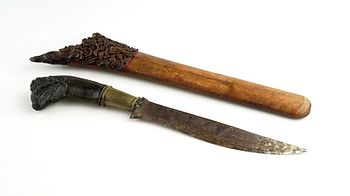Wedung
| Wedung | |
|---|---|
 ABalinesestyle Wedung, pre-1939. | |
| Type | Ceremonial Knife, Machete |
| Place of origin | Indonesia |
| Service history | |
| Used by | Balinese people,Javanese people |
| Specifications | |
| Length | approximately 30 to 35 cm (12 to 14 in) |
| Bladetype | Straight back blade with convex edge |
| Hilttype | Wood, buffalo horn |
| Scabbard/sheath | Wood, buffalo horn fittings |
Wedung(orWedoeng,Wedong) is a traditional large knife of theJavanese peopleand theBalinese peopleoriginating fromIndonesia.
Description
[edit]The Wedung is a short and broad machete (Bendho[1]). Its blade has a straight back and an S-shape edge. It may be made of smooth iron, but pamor forge work also occurs. The back is sometimes sharpened along 1/3 of its length from the point. The blade's base is straight and stands at an angle of 90 degrees to the back. This base usually has decoration shaped as filed-out indentations or small teeth (greneng). A round 'eye' or hole (kembang kacang) is sometimes found. Furthermore, the base may be decorated with inlay work and representations of mythical dragon (naga), leaf and floral motifs. The tang (peksi) is made out of the blade's thick back rim. Between the spike and the blade, a pentagonal segment (metokor integral bolster) is forged. The short hilt, which is pentagonal onJava,forms as it were, an extension of themetok.The hilt is usually made of wood, but other materials such as animal tooth are also found. Its smooth upper part is flattened. The Wedung onBalihas narrower shape and is usually more lavishly decorated. On the rear near the base a lengthy decoration is sometimes added. The hilt and themetokof theBalineseWedung are instead of pentagonal, usually round in cross-section. It is sometimes chiselled. The wooden scabbard usually follows the blade's shape, but may have a rectangular lower part. Its mouth has a broadened rim all around. At the rear side the scabbard has a large horn hook shaped (sangkletan) resembling a shoe-horn, with which the Wedung can be hitched onto the belt. This hook is attached to the scabbard by means of strips of horn, rattan or metal. On expensive examples the scabbard sometimes has one or two round or comma-shaped golden or silver mounts.[2]
Culture
[edit]The Wedung is a peculiar weapon, in the shape of a chopper, worn on occasions of the state by all chiefs when in the presence of the sovereign.[3]It is carried in the palace (kraton) as a symbol of servitude to thesultanfor performing tasks such as cutting of shrubs or even the most humble work such as grass cutting. It is therefore, no longer a real weapon but rather a work-tool carried on the left hip and used as personal decoration.[2]Unlike theKeriswhich is only meant for men, the Wedung can be worn by both men and women in thekraton.[4]
See also
[edit]References
[edit]- ^Amir Mertosedono (1987).Mengenal Senjata Tradisional Kita.Dahara Prize.ASINB0000D7JZJ.
- ^abAlbert G Van Zonneveld (2002).Traditional Weapons of the Indonesian Archipelago.Koninklyk Instituut Voor Taal Land.ISBN90-5450-004-2.
- ^Thomas Stamford Raffles (1830).The History of Java.John Murray.ASINB005ZI21FY.
- ^Heru Basuki (2007).Dakwah Dinasti Mataram Dalam Perang Diponegoro, Kyai Mojo & Perang Sabil Sentot Ali Basah.Samodra Ilmu.ISBN978-602-8014-01-4.
Further reading
[edit]- George Cameron Stone, Donald J. LaRocca (January 1999),A Glossary of the Construction, Decoration and Use of Arms and Armor: in All Countries and in All Times,Courier Dover Publications (published 1999), p. 665 & 666,ISBN978-0-486-40726-5





